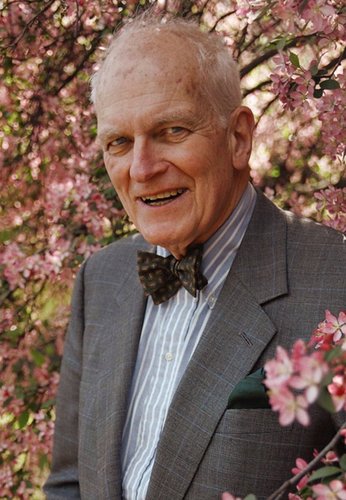Re Ian Bremmer 'Could third-party candidates upend the 2024 US election?' 3 April The current political movement in the USA…
Francis H. (Frank) Cabot R.I.P.
Written by Diana Thebaud Nicholson // December 1, 2011 // Absent Friends, People Meta // 1 Comment

(New York Times) Francis H. Cabot, a financier and self-taught horticulturalist who created two of the most celebrated gardens in North America and helped preserve scores of others, died on Nov. 19 at his home in La Malbaie, Quebec. He was 86.
The cause was idiopathic pulmonary fibrosis, his son, Colin, said.
In 1989, Mr. Cabot founded the Garden Conservancy, a nonprofit organization based in Cold Spring, N.Y., that works to preserve America’s most extraordinary private gardens. [See The Garden Conservancy for a tribute and his authorized obituary]
Mr. Cabot was a hands-on horticulturalist — the magazine House Beautiful once described him as being “as likely to be wearing dungarees with kneepads strapped on and pruning shears holstered in the back pocket as he is a blazer and bow tie” — who built two extraordinary gardens himself.
The first, Stonecrop Gardens, is in Cold Spring, 55 miles north of Midtown Manhattan, on the property where Mr. Cabot and his wife made their home from the 1950s to the early ’90s. Now open to the public from April to October, Stonecrop features 12 acres of woodlands, grasses, bulbs, alpine plants and rock gardens.
The second, Les Quatre Vents (the Four Winds), is on his family’s estate in La Malbaie, beside the St. Lawrence River. Open four days each summer, it covers more than 20 acres and is widely considered one of the most ambitious private gardens in North America, if not the world.
Mr. Cabot’s book about his cultivation of that garden for decades, “The Greater Perfection: The Story of the Gardens at Les Quatre Vents,” was published in 2001.
A son of the New York branch of one of Boston’s storied families, Francis Higginson Cabot Jr., familiarly known as Frank, was born in Manhattan on Aug. 6, 1925. After serving with the Army occupation forces in Japan at the end of World War II, he received a bachelor’s degree from Harvard in 1949.
Mr. Cabot began his career as an executive assistant at Stone & Webster, the engineering and investment banking company of which his father was a vice president.
He became a partner at Train, Cabot & Associates, an investment and venture capital concern, in 1959. He became a gardener, he said afterward, to relieve the pressures of venture capitalism.
“I was a good promoter,” Mr. Cabot told The Courier-Journal of Louisville, Ky., in 2003. “But I was a good promoter of ventures that didn’t always work out. So I threw myself into gardening.”
In the late 1980s Mr. Cabot, by then a consummate plantsman, visited Ruth Bancroft, renowned in horticultural circles for the “dry garden” — thousands of cactuses, succulents and shrubs — she began in the 1950s on her property in Walnut Creek, Calif.
By the time of his visit, Mrs. Bancroft was in her early 80s. Worried that her garden would die with her, Mr. Cabot founded the Garden Conservancy.
To date, the organization has helped preserve more than 90 gardens, including those of the Longue Vue House and Gardens in New Orleans, ravaged by Hurricane Katrina, and the gardens of Alcatraz, which were tended by prison inmates and their guards for more than a century.
The conservancy’s inaugural project, the Ruth Bancroft Garden, continues to thrive and is now open to the public year-round. (In this case, at least, Mr. Cabot’s preservationist zeal may have been a trifle premature: Mrs. Bancroft, now 103, still lives on the property.)
Mr. Cabot, who retired from Train, Cabot in 1976, was chairman of the New York Botanical Garden from 1973 to 1976. His other horticultural posts include distinguished adviserships to the Brooklyn Botanic Garden and the Royal Botanical Gardens in Burlington, Ontario.
Besides his son, Mr. Cabot is survived by his wife, Anne Perkins Cabot, whom he married in 1949; two daughters, Currie Barron and Marianne Welch; nine grandchildren; and five great-grandchildren. An admirer of fauna as well as flora, he also had homes on a sheep station in Manapouri, New Zealand, and in Loudon, N.H.
At Les Quatre Vents, after members of the public had navigated its lawns, meadows, streams, hedges and woodlands; traversed its Nepalese rope bridges over lush ravines; admired its riotous floral displays (including 10-foot-high delphiniums and Himalayan blue poppies, no mean feat to coax from North American soil); explored its Japanese garden — and its white garden, rose garden, rock garden, shade garden and kitchen garden; lingered at its reflecting pools, waterfalls and lily ponds; walked round its pavilions, sculptures and topiary; and paused before its massive outdoor oven and ornate, towering “pigeonnier,” as Mr. Cabot’s dovecote is known, they were sometimes surprised, at journey’s end, to encounter Mr. Cabot.
He invariably had a question: Had they found their odyssey emotionally exhausting?
Those brave enough to answer yes were met with a characteristic reply.
“Good,” said Mr. Cabot, genuinely gratified.
His Quebec garden called ‘Canada’s best-kept secret’
By Alan Hustak
(Globe & Mail) Francis (Frank) Cabot was a patrician U.S. financier and self-taught horticulturalist whose enduring legacy is an enchanting 15-hectare private garden in Cap l’Aigle, Que. Known as Les Quatre Vents, the garden was personally maintained by him for more than 50 years on the family’s historic estate on the North Shore of the lower St. Lawrence. … “He was an avid gardener, rumpled and dishevelled even when he was in a business suit and bow tie,” said Diana Thébaud Nicholson, a member of another of the so-called Murray Bay families. “He was one of the nicest, most courteous people I have ever met. Everyone credits him for the gardens, but not for everything else he did for the community. He established a non-profit foundation, Héritage Charlevoix, to protect historic properties, like the mill and bakery in Baie-Saint-Paul, and he and his wife imported livestock to Charlevoix – Highland cattle, Jacob sheep and Norwegian Fjord ponies. He loved to ride.”
Remembering Francis Cabot
(CBC) He was from one of America’s most famous families, and his legacy is one of Quebec’s most spectacular gardens. Francis Cabot died over the weekend at his beloved home in the Charlevoix. Garden writer Larry Hodgson joined us to talk about the man behind the Cabot
Frank Cabot: A Man with a Passion (lovely photos)
A self-proclaimed romantic when it comes to landscape and food, Frank became a gardener when he married Anne Perkins, herself fascinated with plants. Their garden at Les Quatre Vents in La Malbaie, Quebec, has been acclaimed as one of the most beautiful gardens in North America. It wouldn’t belong on this baker’s blog however except for the link between Frank, Anne and Boulangerie La Rémy
The Gift of Bread
The taste of a madeleine crumbled in a spoonful of tea suddenly brought back to Proust whole sections of his past previously hidden from his consciousness and In Search of Lost Time was born. Stretching things a bit, it could be argued that Frank Cabot whom I met during a recent trip to La Malbaie, Charlevoix County (Central Quebec), had the opposite experience. He recalled vividly how life was in the area in the twenties and thirties (“Food-wise it was a paradise, just like France. But everything changed after World War II. Nothing tasted the same afterwards”) and what he wanted back was that taste.
Moved by a deep affection for Charlevoix County where his family has been living/summering for nine generations, and very much aware of the fact that, in this corner of the North Shore of the Saint-Lawrence River , the past was being erased not only from the culture but also from the landscape, Frank and his wife Anne founded Heritage Charlevoix, a land trust whose sole raison d’être was to preserve the county’s heritage by buying and restoring its old buildings. One of the buildings thus saved from neglect and ultimately destruction was the “moulin de la Rémy” (the mill on the Rémy River) in Baie-Saint-Paul, 50 km (31 miles) south of La Malbaie.
Les Quatre Vents–An Extraordinary Garden
… Mr. Cabot wanted French singer Charles Trenet’s Le Jardin Extraordinaire to play whenever people walked into the Pigeonnier (building shown above):




One Comment on "Francis H. (Frank) Cabot R.I.P."
In terms of a practical understanding of nature, compared to the bees we are but infants.
When the ‘counter-culture’ movement was in full swing in the United
States in the late 1960s, many younger people began a
‘back to the earth’ movement in an attempt to draw a closer connection the land that
they instinctively knew sustained them. The weekly Farmers
Market becomes a ritual for those seeking wholesome, organic foods that
promote health through harvest direct from local
Producers.